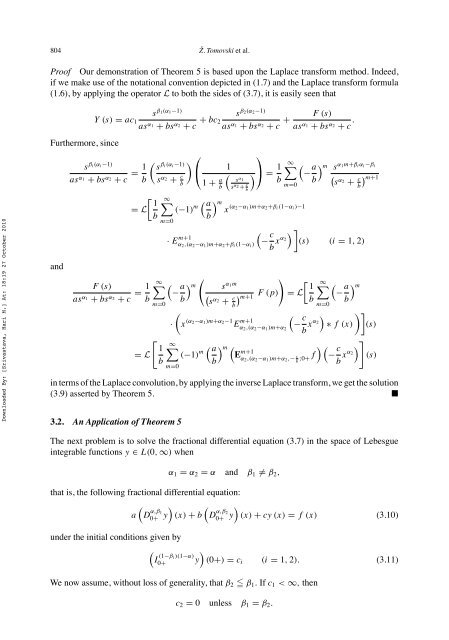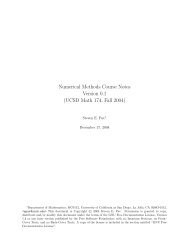Fractional and operational calculus with generalized fractional ...
Fractional and operational calculus with generalized fractional ...
Fractional and operational calculus with generalized fractional ...
Create successful ePaper yourself
Turn your PDF publications into a flip-book with our unique Google optimized e-Paper software.
804 Ž. Tomovski et al.<br />
Proof Our demonstration of Theorem 5 is based upon the Laplace transform method. Indeed,<br />
if we make use of the notational convention depicted in (1.7) <strong>and</strong> the Laplace transform formula<br />
(1.6), by applying the operator L to both the sides of (3.7), it is easily seen that<br />
Downloaded By: [Srivastava, Hari M.] At: 18:19 27 October 2010<br />
Furthermore, since<br />
<strong>and</strong><br />
s β 1(α 1 −1)<br />
s β 2(α 2 −1)<br />
F (s)<br />
Y (s) = ac 1 + bc<br />
as α 1 + bs<br />
α 2 +<br />
.<br />
2 + c as α 1 + bs<br />
α 2 + c as α 1 + bs<br />
α 2 + c<br />
s β i(α i −1)<br />
= 1 ( s<br />
β i (α i −1)<br />
) ⎛ ⎝<br />
1<br />
as α 1 + bs<br />
α 2 + c b s α 2 +<br />
c<br />
b 1 + a b<br />
[ 1<br />
∞∑<br />
= L<br />
b<br />
F (s)<br />
as α 1 + bs<br />
α 2 + c<br />
= 1 b<br />
= L<br />
m=0<br />
∞∑<br />
m=0<br />
[<br />
1<br />
b<br />
(<br />
s α 1<br />
s α 2 + c b<br />
⎞<br />
) ⎠ = 1 b<br />
∞∑<br />
m=0<br />
(<br />
(−1) m a<br />
) m<br />
x<br />
(α 2 −α 1 )m+α 2 +β i (1−α i )−1<br />
b<br />
· E m+1<br />
α 2 ,(α 2 −α 1 )m+α 2 +β i (1−α i )<br />
(<br />
− a b<br />
) m<br />
(<br />
s α 1m<br />
(<br />
s<br />
α 2 +<br />
c<br />
b<br />
(<br />
− a ) m s α 1m+β i α i −β i<br />
(<br />
b s<br />
α 2 +<br />
c<br />
b<br />
(<br />
− c b xα 2) ] (s) (i = 1, 2)<br />
) m+1<br />
F (p)<br />
)<br />
[ 1<br />
= L<br />
b<br />
(<br />
(<br />
· x (α 2−α 1 )m+α 2 −1 E m+1<br />
α 2 ,(α 2 −α 1 )m+α 2<br />
− c b xα 2<br />
∞∑<br />
m=0<br />
∞∑<br />
m=0<br />
(<br />
− a ) m<br />
b<br />
)<br />
∗ f (x)<br />
) m+1<br />
)]<br />
(s)<br />
(<br />
(−1) m a<br />
) m (<br />
)(<br />
E m+1<br />
α<br />
b<br />
2 ,(α 2 −α 1 )m+α 2 ,− c ;0+f − c 2) ]<br />
b b xα (s)<br />
in terms of the Laplace convolution, by applying the inverse Laplace transform, we get the solution<br />
(3.9) asserted by Theorem 5. <br />
3.2. An Application of Theorem 5<br />
The next problem is to solve the <strong>fractional</strong> differential equation (3.7) in the space of Lebesgue<br />
integrable functions y ∈ L(0, ∞) when<br />
α 1 = α 2 = α <strong>and</strong> β 1 ̸= β 2 ,<br />
that is, the following <strong>fractional</strong> differential equation:<br />
( ) ( )<br />
a D α,β 1<br />
0+ y (x) + b D α,β 2<br />
0+ y (x) + cy (x) = f (x) (3.10)<br />
under the initial conditions given by<br />
(<br />
)<br />
I (1−β i)(1−α)<br />
0+ y (0+) = c i (i = 1, 2). (3.11)<br />
We now assume, <strong>with</strong>out loss of generality, that β 2 ≦ β 1 . If c 1 < ∞, then<br />
c 2 = 0 unless β 1 = β 2 .














